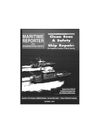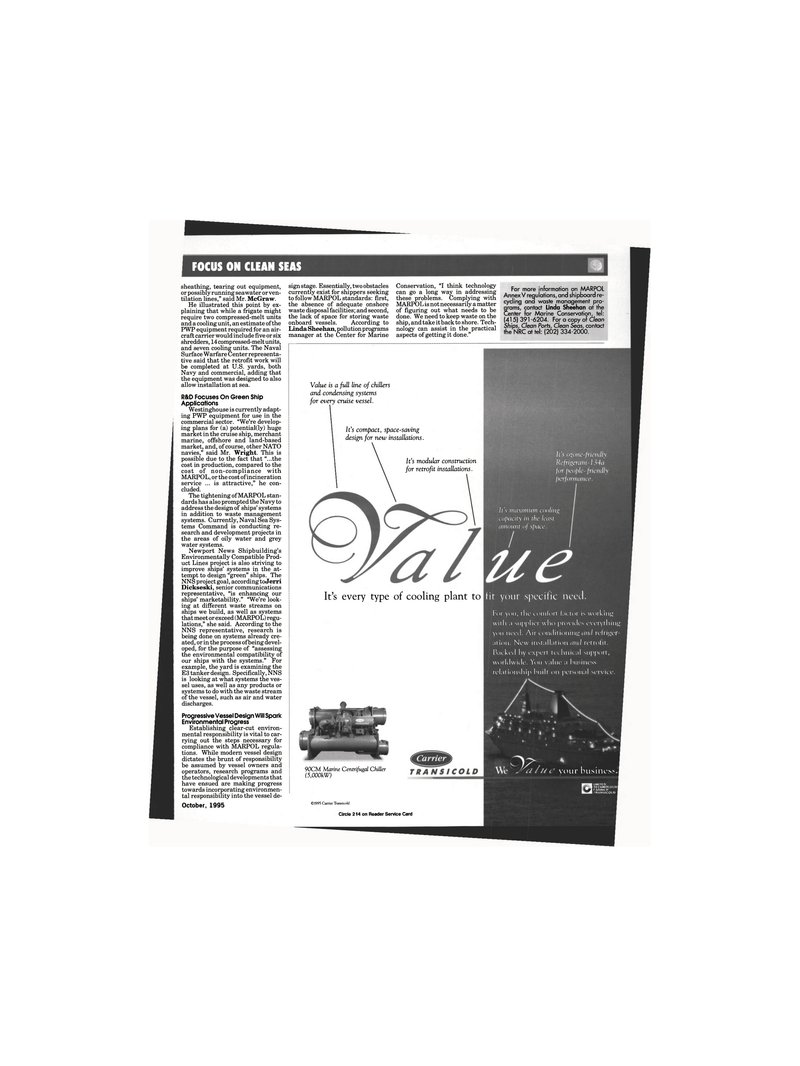
Page 29: of Maritime Reporter Magazine (October 1995)
Read this page in Pdf, Flash or Html5 edition of October 1995 Maritime Reporter Magazine
It's ozone-friendly
Refrigerant-134a for people- friendly performance.
UNITED
TECHNOLOGY
CftRFM (! TRAN5IC0LD
FOCUS ON CLEAN SEAS sheathing, tearing out equipment, or possibly running seawater or ven- tilation lines," said Mr. McGraw.
He illustrated this point by ex- plaining that while a frigate might require two compressed-melt units and a cooling unit, an estimate of the
PWP equipment required for an air- craft carrier would include five or six shredders, 14 compressed-melt units, and seven cooling units. The Naval
Surface Warfare Center representa- tive said that the retrofit work will be completed at U.S. yards, both
Navy and commercial, adding that the equipment was designed to also allow installation at sea.
R&D Focuses On Green Ship
Applications
Westinghouse is currently adapt- ing PWP equipment for use in the commercial sector. "We're develop- ing plans for (a) potentially) huge market in the cruise ship, merchant marine, offshore and land-based market, and, of course, other NATO navies," said Mr. Wright. This is possible due to the fact that "...the cost in production, compared to the cost of non-compliance with
MARPOL, or the cost of incineration service ... is attractive," he con- cluded.
The tightening of MARPOL stan- dards has also prompted the Navy to address the design of ships' systems in addition to waste management systems. Currently, Naval Sea Sys- tems Command is conducting re- search and development projects in the areas of oily water and grey water systems.
Newport News Shipbuilding's
Environmentally Compatible Prod- uct Lines project is also striving to improve ships' systems in the at- tempt to design "green" ships. The
NNS project goal, according to Jerri
Dickseski, senior communications representative, "is enhancing our ships' marketability." "We're look- ing at different waste streams on ships we build, as well as systems that meet or exceed (MARPOL) regu- lations," she said. According to the
NNS representative, research is being done on systems already cre- ated, or in the process of being devel- oped, for the purpose of "assessing the environmental compatibility of our ships with the systems." For example, the yard is examining the
E3 tanker design. Specifically, NNS is looking at what systems the ves- sel uses, as well as any products or systems to do with the waste stream of the vessel, such as air and water discharges.
Progressive Vessel Design Will Spark
Environmental Progress
Establishing clear-cut environ- mental responsibility is vital to car- rying out the steps necessary for compliance with MARPOL regula- tions. While modern vessel design dictates the brunt of responsibility be assumed by vessel owners and operators, research programs and the technological developments that have ensued are making progress towards incorporating environmen- tal responsibility into the vessel de-
October, 1995 31
It's maximum cooling capacity in the least amount of space. fit your specific need.
For you, the comfort factor is working will) a supplier who provides everything you need. Air conditioning and refriger ation. New installation and retrofit.
Backed hy expert technical support, worldwide. You value a business relationship huilt on personal service your bu sine's^ sign stage. Essentially, two obstacles currently exist for shippers seeking to follow MARPOL standards: first, the absence of adequate onshore waste disposal facilities; and second, the lack of space for storing waste onboard vessels. According to
Linda Sheehan, pollution programs manager at the Center for Marine
Conservation, "I think technology can go a long way in addressing these problems. Complying with
MARPOL is not necessarily a matter of figuring out what needs to be done. We need to keep waste on the ship, and take it back to shore. Tech- nology can assist in the practical aspects of getting it done."
For more information on MARPOL
Annex V regulations, and shipboard re- cycling ana waste management pro- grams, contact Linda Sheehan at the
Center for Marine Conservation, tel: (415) 391 -6204. For a copy of Clean
Ships, Clean Ports, Clean Seas, contact the NRC at tel: (202) 334-2000.
It's compact, space-saving design for new installations.
It's modular construction for retrofit installations.
It's every type of cooling plant to ©1995 Carrier Transicold
Circle 214 on Reader Service Card
Value is a full line of chillers and condensing systems for every cruise vessel. 90CM Marine Centrifugal Chiller (5,000kW)

 28
28

 30
30
